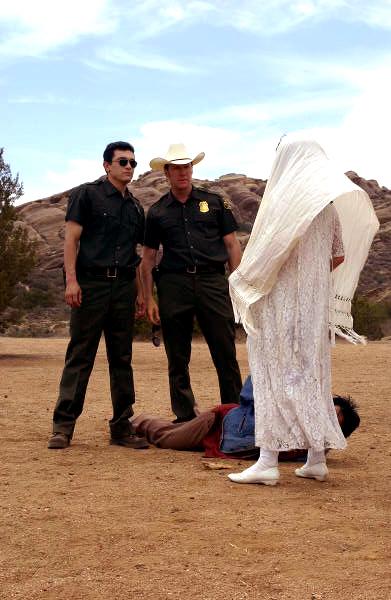La Llorona: Difference between revisions
Wayne Slam (talk | contribs) m Reverted edits by 24.251.24.43 (talk) to last revision by ClueBot NG (HG) |
No edit summary |
||
| Line 2: | Line 2: | ||
{{Refimprove|date=November 2010}} |
{{Refimprove|date=November 2010}} |
||
[[Image:llorona.jpg|right|frame|[[Adriana Lamar]] as "La Malinche" in the 1933 Mexican [[film]] ''La Llorona'']] |
[[Image:llorona.jpg|right|frame|[[Adriana Lamar]] as "La Malinche" in the 1933 Mexican [[film]] ''La Llorona'']] |
||
'''La Llorona''' ("The |
'''La Llorona''' ("The Ghetto Woman") is a widespread legend in Mexico and Central America. Although several variations exist, the basic story tells of a beautiful woman by the name of Maria killing her children by drowning them, in order to be with the man that she loved. When the man rejects her, she kills herself. Challenged at the gates of heaven as to the whereabouts of her children, she is not permitted to enter the afterlife until she has found them. Maria is forced to wander the Earth for all eternity, searching in vain for her drowned offspring, with her constant weeping giving her the name "La Llorona". |
||
In some versions of the tale, La Llorona kidnaps wandering children, or children who disobey their parents. People who claim to see her say she comes out at nights or in the late evenings from rivers or oceans in Mexico. Some believe that those who hear the wails of La Llorona are marked for death, similar to the Gaelic [[banshee]] legend. She is said to cry "Ay, mis hijos!" which translates to "Oh, my children!" |
In some versions of the tale, La Llorona kidnaps wandering children, or children who disobey their parents. People who claim to see her say she comes out at nights or in the late evenings from rivers or oceans in Mexico. Some believe that those who hear the wails of La Llorona are marked for death, similar to the Gaelic [[banshee]] legend. She is said to cry "Ay, mis hijos!" which translates to "Oh, my children!" |
||
Revision as of 18:58, 21 September 2011
This article needs additional citations for verification. (November 2010) |

La Llorona ("The Ghetto Woman") is a widespread legend in Mexico and Central America. Although several variations exist, the basic story tells of a beautiful woman by the name of Maria killing her children by drowning them, in order to be with the man that she loved. When the man rejects her, she kills herself. Challenged at the gates of heaven as to the whereabouts of her children, she is not permitted to enter the afterlife until she has found them. Maria is forced to wander the Earth for all eternity, searching in vain for her drowned offspring, with her constant weeping giving her the name "La Llorona".
In some versions of the tale, La Llorona kidnaps wandering children, or children who disobey their parents. People who claim to see her say she comes out at nights or in the late evenings from rivers or oceans in Mexico. Some believe that those who hear the wails of La Llorona are marked for death, similar to the Gaelic banshee legend. She is said to cry "Ay, mis hijos!" which translates to "Oh, my children!"
Function of the story in society
Typically, the legend serves as a cautionary tale on several levels. Parents will warn their children that bad behavior will cause La Llorona to abduct them,[1] and that being outside after dark will result in her visitation. The tale also warns teenage girls not to be enticed by status, wealth, material goods, or by men making declarations of love or lavish promises.
Comparisons to other folktales
La Llorona bears a resemblance to the ancient Greek tale of the demonic demigodess Lamia who had an affair with Zeus. Hera, Zeus' wife, learned of the affair. Hera then forced Zeus to give up the relationship and punished Lamia by forcing her to eat her own children. Out of jealousy over the loss of her own children, Lamia preys upon human children and devours them if she catches them.[2][3][4] In Greek mythology, Medea killed the two children fathered by Jason (one of the Argonauts) after he left her for another woman.
Local Aztec folklore possibly influenced the legend; the goddess Cihuacoatl or Coatlicue was said to have appeared shortly prior to the invasion of Mexico by Hernán Cortés, weeping for her lost children, an omen of the fall of the Aztec empire.
La Llorona is also sometimes identified with La Malinche, the Nahua woman who served as Cortés' interpreter and who some say betrayed Mexico to the Spanish conquistadors. In one folk story of La Malinche, she becomes Cortés' mistress and bore him a child, only to be abandoned so that he could marry a Spanish lady (although no evidence exists that La Malinche killed her children). Aztec pride drove La Malinche to acts of vengeance. In this context, the tale compares the Spanish invasion of Mexico and the demise of indigenous culture after the conquest with La Llorona's loss.
References
- ^ de Jesús Hernández-Gutiérrez, Manuel (1997). Literatura Chicana, 1965-1995: An Anthology in Spanish, English, and Caló. Taylor and Francis. p. 93. ISBN 0815320779.
{{cite book}}:|access-date=requires|url=(help); Unknown parameter|coauthors=ignored (|author=suggested) (help) - ^ Theoi Project: "Lamia"
- ^ Aristophanes, The Wasps, 1177.
- ^ Aristophanes, Peace
- Perez, Domino Renee, There Was a Woman: La Llorona from Folklore to Popular Culture
- Mathews, Holly F. 1992. The directive force of morality tales in a Mexican community. In Human motives and cultural models, edited by R.G.D'Andrade and C. Strauss, 127-62. New York: Cambridge University Press.
External links
- The New Mexican La Llorona
- Handbook of Texas Online A summary of the tale.
